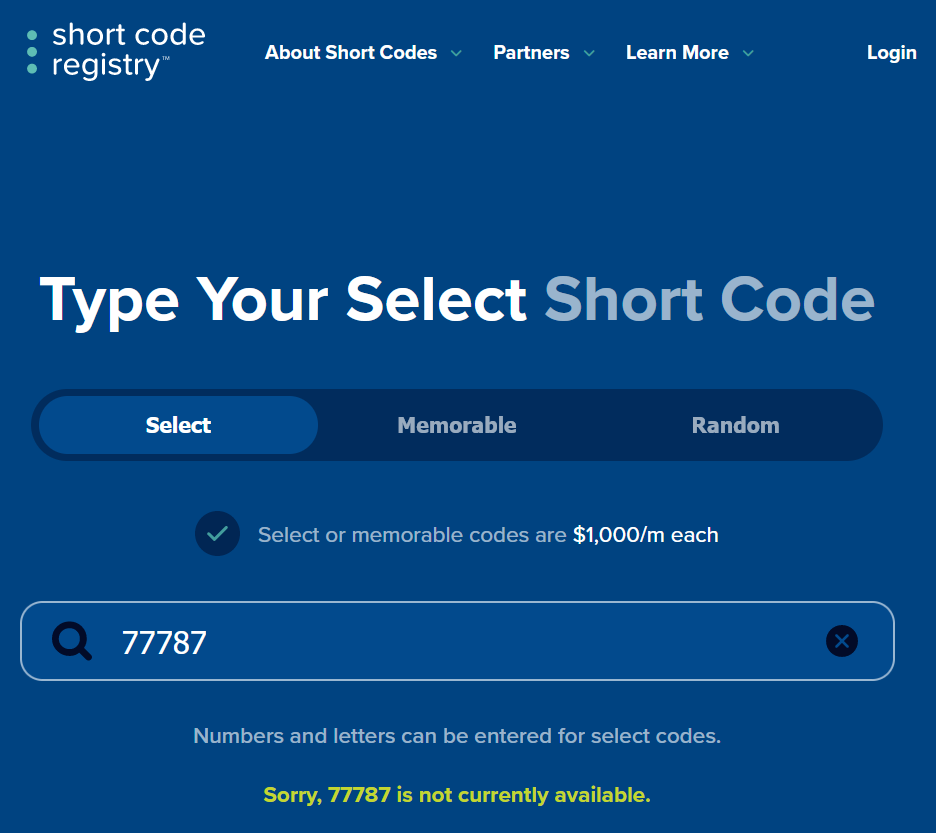📑 Table of Contents
Ever marveled at how you quickly vote for your favorite talent show star or grab that flash sale coupon? At the heart of this instant magic is something called an SMS shortcode. If you want to decode this secret, you’re in the right place.
In the simplest terms, an SMS short code is a 5 to 6-digit number that businesses utilize to send and receive texts from consumers. Unlike the regular phone numbers we’re used to, these are concise, making them a marketer’s dream. They stand out, are easy to remember, and promise higher engagement rates.
What Are the Uses of SMS Short Codes?
What’s the big fuss about these numbers? Well, their potential applications are vast:
- Promotional Campaigns: Flash sales, discount codes, and exclusive offers.
- Notifications: From banks updating you about your account balance to airlines informing you about flight changes.
- Interactive TV: Voting for participants, entering competitions, or even requesting songs on radio channels.
- Feedback and Surveys: Directly sourcing opinions from consumers.
- Subscriptions: Registering for regular updates or newsletters from brands.
- Charity: Making quick donations.
How Do Short Codes Work?
Here’s the cool part. When you send a text to a short code, it doesn’t end up on another mobile. Instead, it hits a software application that processes the information and sends a response, be it a thank-you note, a discount code, or a confirmation.
A great example is having an SMS Keyword. Then, you can advertise the SMS keyword to your audience. Your audience then texts in the keyword to join your texting list.
Text “MOJITO” to 41242
This is a great example below of the idea of using a short code and text keyword:

How to Get SMS Short Codes?
Acquiring SMS short codes involves a formal process and is typically coordinated through authorized telecommunication providers and the appropriate regulatory authorities. Here are the general steps to obtain an SMS shortcode:
- Determine Your Use Case: Identify the purpose for which you need the shortcode. Is it for marketing, customer support, emergency alerts, or another specific application? Understanding your use case is essential because it will help you choose the appropriate type of shortcode.
- Select the Type of Short Code: There are two main types of SMS short codes: dedicated short codes and shared short codes.
- Dedicated Short Codes: These are exclusive to a single business or organization. They are more expensive but offer greater control and branding. Dedicated short codes are typically used for high-volume or critical applications.
- Shared Short Codes: Multiple businesses or organizations share these codes. They are more cost-effective but may have some limitations, such as keyword conflicts. Shared short codes are suitable for smaller businesses or those with lower messaging volumes.
- Choose a Short Code Provider: You’ll need to work with a Short Code Registry Service Provider (RSP), which is typically a mobile messaging aggregator or a telecom service provider. Research and select a reputable RSP that can assist you in obtaining and managing your shortcode.
- Apply for a Short Code: Your chosen RSP will guide you through the application process, which typically includes:
- Providing detailed information about your intended use of the shortcode.
- Specify the keywords you plan to use with the shortcode.
- Demonstrating compliance with applicable regulations, including the Telephone Consumer Protection Act (TCPA) in the United States.
- Receive Approval: The approval process can take some time, and it involves review and verification by the appropriate regulatory authorities in your country. Once your application is approved, you’ll receive the assigned short code.
- Implement the Short Code: After receiving the short code, work with your RSP to set up the technical infrastructure to send and receive SMS messages through the code. You’ll also configure keyword-based triggers for the desired actions or responses.
- Promote Your Short Code: Once your short code is operational, promote it to your target audience or customers. Encourage them to text the keyword to the shortcode to engage with your services or receive information.
- Launch Your Campaign: Congratulations! Begin your direct SMS communication and marketing campaigns!
- Compliance and Best Practices: Ensure that you remain in compliance with all relevant regulations and guidelines for SMS marketing and communications. Be transparent about the type and frequency of messages you’ll send to subscribers, and provide opt-in and opt-out options.
- Maintain and Monitor: Continuously monitor the performance of your short code campaigns, manage your subscriber lists, and make necessary adjustments based on user feedback and analytics.
The specific steps and requirements may vary depending on your location and the regulations governing shortcodes in your country. It’s essential to work with a qualified provider or RSP who can guide you through the process and ensure that you’re compliant with all legal and industry standards.

A Sample campaign flow: You will need to provide the exact campaign flow. Sample of messages, such as:
- Text MOJITO to join, you will receive up to 2 messages per month.
- For HELP, call 212-222-2222 or support @ somedomain.com
- STOP – you are unsubscribed from our list.
* For complete examples and guidance, contact your selected text message provider.
What is The Cost?
The cost of SMS short codes varies depending on the type of code you choose and the service provider. There are two types of short codes: vanity and non-vanity.
- Vanity Short Codes: These are custom numbers that you can choose, typically because they’re easy to remember or spell out something relevant to your brand. The cost for a vanity short code is generally higher than for a non-vanity code. You can expect to pay around $1,000 per month for a vanity short code.
- Non-Vanity Short Codes: These are randomly assigned numbers. They are less expensive than vanity codes, with the cost typically around $500 per month.
It’s important to note that these costs are just for leasing the short code itself. Additional costs may be associated with the setup, maintenance, and the volume of messages sent. Also, the process of acquiring a short code involves compliance with carrier regulations and approval processes, which can add to the cost.
The pricing can also vary based on the provider and any additional services or features that you might require for your SMS marketing campaigns. It’s best to consult with a few SMS providers to get an understanding and quote of the costs involved for your specific needs and to ensure compliance with all relevant regulations. Keep in mind that provisioning short code may take about 3 months.
Who Uses SMS Short Codes?
SMS short codes are used by a variety of organizations and individuals for different purposes. Some common users of SMS short codes include:
- Businesses: Many businesses use SMS short codes for marketing and customer engagement. They might send promotional offers, conduct surveys, or provide customer support through these shortcodes. For example, a retail store might use a short code for customers to text to receive discounts or product information.
- Nonprofit Organizations: Nonprofits often use SMS short codes to raise funds or increase awareness of their causes. Donors can text a short code to make a donation or receive updates on the organization’s activities.
- Government Agencies: Government agencies use shortcodes for various purposes, such as emergency alerts, voting information, and public service announcements. For instance, a local government might use a short code to notify residents about severe weather warnings.
- Television and Radio Shows: TV and radio shows use shortcodes for audience participation. Viewers or listeners can vote for their favorite contestants or answer polls by texting a specific shortcode.
- Mobile Service Providers: Mobile carriers use shortcodes for various purposes, including checking account balances, purchasing mobile services, and managing subscriptions.
- Financial Institutions: Banks and financial institutions may use shortcodes for services like checking account balances, transaction notifications, or even transferring funds.
- Transportation Companies: Airlines, railways, and bus companies use shortcodes for services like flight status updates, ticket bookings, and boarding pass retrieval.
- Event Organizers: Event organizers use shortcodes to distribute event-related information, sell tickets, and conduct contests or surveys related to the event.
- Educational Institutions: Schools, colleges, and universities might use shortcodes to provide information about admissions, class schedules, or campus updates.
- Media and Entertainment Companies: Media outlets and entertainment companies may use shortcodes for contests, promotions, or to deliver content updates to subscribers.
- Healthcare Providers: Healthcare organizations might use shortcodes for appointment reminders, prescription refill requests, or health-related information dissemination.
- Technology Companies: Tech companies may use shortcodes to provide tech support, software downloads, or product information.
- Consumer Services: Various consumer services, such as ride-sharing companies, food delivery services, and e-commerce platforms, use shortcodes to facilitate user interactions and transactions.
- Emergency Services: Emergency services and first responders use shortcodes for sending alerts and important information during emergencies. For instance, a short code may be used to notify residents of a natural disaster, a missing person, or instructions during a crisis.
- Membership Organizations: Membership-based organizations, such as gyms, clubs, and loyalty programs, often use shortcodes to communicate with their members. Members can use these codes to check their membership status, receive updates on events, or access exclusive discounts.
It’s important to note that the specific use of SMS short codes may vary by country and region, and they are often regulated to ensure consumer protection and privacy. Users typically initiate interactions by sending a keyword to a short code, and the response or action depends on the organization’s configured system for that code.
SMS Short Code Spoofing
While technology empowers, it also invites miscreants. Spoofing or faking the sender ID in texts is a challenge. However, reputable providers prioritize security measures to combat such threats. Always be vigilant!

Should I Buy a Short Code Or Other Types of SMS Sender?
The world of SMS is broader than you might think:
- Short Codes: Ideal for businesses eyeing national visibility.
- Toll-Free (TFN): Perfect when you want the receiver to incur zero costs.
- 10DLC: Regular 10-digit SMS numbers (a.k.a 10DLC) with a personal touch.
- Local Long Codes: Tailored for businesses wanting a local feel. It’s great if you run an international campaign. Then, for each country, you can have a local long code. Better delivery and does not look spammy. Why spammy? Imagine you live in the U.K., but receive SMS from a USA number. You might think it’s a fraud or scam. Better use local long codes.
The decision boils down to your target audience, scale, and budget.

How to Choose a Short Code Provider?
This is crucial. Here are a few pointers to consider:
- Security Protocols: Anti-spoofing and encryption are vital.
- Transparent Pricing: No one likes hidden surprises. YepText offers competitive prices and no hidden fees.
- Support System: An accessible and knowledgeable team is gold.
- Features Galore: Look for customizable options, analytics, and automation.
Check out our great SMS providers’ reviews. You will be able to shortlist 2-3 providers and start the talks with them. Ask about pricing, compliance, data security, SMS speed, and time to provision TFN or short code.
A Glimpse into the Future: What’s Next?
While SMS short codes have made a significant mark, the ever-evolving tech landscape means that we can expect more innovations in this arena. Experts predict:
- Integration with AI: Imagine chatbots and virtual assistants responding via shortcodes.
- Enhanced Security: As cyber threats evolve, so will security measures to counteract them.
- Rich Media Messaging: Incorporating multimedia elements like GIFs, videos, and interactive buttons within SMS campaigns.
- Seamless Integration with Other Platforms: Think about a scenario where your CRM, email marketing tools, and SMS campaigns all communicate seamlessly.
Final Thoughts…
SMS short codes, while concise, pack a punch. They’ve revolutionized the way businesses communicate, bridging the gap between brands and consumers. Whether you’re a budding startup or an established brand, understanding and harnessing the power of shortcodes can significantly boost your engagement rates, foster loyalty, and drive conversions.
While we’ve delved deep into the world of SMS short codes in this post, it’s essential to understand the broader picture of how these codes fit into the larger strategy of SMS marketing.
Remember, as with any digital tool, it’s essential to prioritize the user experience. Ensure your messages add value, respect privacy, and maintain transparency. When used thoughtfully, shortcodes can be more than just numbers; they can be the catalysts for lasting customer relationships.
So, are you ready to dive deep and explore the world of SMS short codes? The future is just a text away!
